Porcelain Insulator News
by Jack H. Tod
Reprinted from "INSULATORS - Crown Jewels of the Wire", June 1975, page 23
Preferably direct porcelain news items and questions directly to Jack H. Tod,
3427 N. 47th Place, Phoenix, Ariz. 85018. All mail will be answered if reply
stamp is enclosed, and the most newsworthy items and questions of general
interest will be published as space permits.

Dear Jack:
I recently acquired a U-402 which has a nice bold KNOX marking
(recess-embossed). It has the typical Knox chocolate brown glaze color.
In April 1973 I acquired a 3" porcelain ceiling rosette with the very
fancy, artistic marking shown by the enclosed foil impression. In the keystone
is what appears to be H. P. Co. or HUT P Co., and note parts of the artistic
letters are twig-like branches.

This marking might tie in with the H. P. Co.
marking found on the cleat of Vance Rightmire (Texas) cited by you in the Nov
1973 CJ, page 26. This marking has been very perplexing to me for some time, and
maybe you can help satisfy my curiosity.
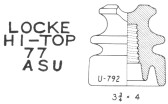
About two years ago I acquired from a high voltage trouble shooting lineman
in the mountains west of Denver, a U-792 Locke Hi-Top #77 with what I think is
a rare marking error for a more recent style of porcelain pin type. Note the
reversed USA (drawing above). This insulator has the incuse marking on the
skirt.
Fred Hildebrand,
Lakewood, Colo.
- - - - - - - - -
Dear Fred:
Many thanks for clearing up the U-402 facts. Turns out Knox made these that
are like the U-402 (some being No Names), and J-D made the ones like the U-402A.
Your guesses at deciphering the monogram marking were a noble try but didn't
hit the mark. Otto Boll (Minneapolis) helped solve this one when he recently
gave me a big double-circuit, fused, entrance switch. It has both the monogram
marking and an embossed H. T. P. Co. (on reverse side). I've since attributed
this to H. T. Paiste Co. Philadelphia, a manufacturer of wiring devices. Their
exclusive distributor was Hart & Hegeman Co. (Hartford).
You get five browny points for reporting the dandy Locke handstamp error, but
you lose four points for waiting two years to let the other Locke fans in on
our secret. I checked with Arizona State Univ. (ASU). and they take no credit
for this free publicity up on the pole tops in Colorado. Locke factory records
indicate this marking was used from Sep 1945 to Nov 1982.
Jack
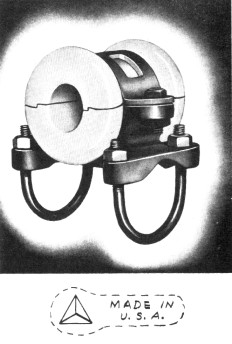
Dear Jack:
My father found this white spool near a factory here in Buffalo. It is odd
because it was made in two pieces and split right down the middle. On the inside
where the pin would go through, it is marked "PART 2995" on both
pieces. The pieces were held together with black electrical tape.
I've sketched the outside marking, but I can't figure out what's inside the
triangle. Please give me any info you have on it.
Jeff lbach
7093 Versailles Rd.
Buffalo, NY 1404T .
- - - - - - - - -
Dear Jeff:
Several companies have a triangle in their trademark, but with the apex
upwards like your sketch, I'll say it is Delta-Star Electric Co., Chicago,
established 1908 and now a Division of H. K. Porter Co. They sold all forms of
poleline hardware. (I've filled in the triangle above to complete the marking
for you.)
What you have are the porcelain bushing parts of a clamp insulator (see
catalog cut above), and there are many forms of these as sold by different
companies over a long period of time (to present). The porcelain parts are
generally useable in any of the clamp forms, and they come with wire hole sizes
from 5/16" up to 3-1/2", the smaller sizes 1" or less being the
most commonly seen (by me).
Someday, anything like this will be a rarity, because it's now nearly
impossible to find anything being sold in this country with "MADE IN
U.S.A." marked on it - at least not in the stores around here!
Jack
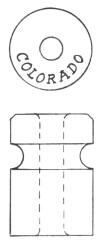
Dear Jack:
I think I may have found a new marking for you. It's on a small knob (sketch
enclosed). I found several of them with wire grooves of different size, and most
of them are partly legible, with only one being fully legible.

I have a U-399B with the incuse COOK stamp. It is unusual in that it has a
medium blue glaze. Almost every Cook insulator that I have seen has been brown,
yellow, or white glaze. Do you know of any other Cook's with this blue glaze?
Phillip Loos,
Durango, Colo
- - - - - - - - -
Dear Phil:
Your # 5-1/2 (old code) knob with COLORADO is a new one on me. I can
understand why Texans (those boys from the sovereign state of cowboy boots and
enormous belt buckles) would require the state name on their electric fence
knobs, but I didn't think Colorado folk were really all that fussy.
Yes, the gray-blue glaze like you have on the Cook U-399B is unusual for
Cook. A dealer had two just like yours at the K.C. Nat'l show in 1972, and they
sold real quick for $25 each. Sure were pretty things. I haven't seen any other
blue Cooks besides those.
Jack
Dear Jack:
At a bottle/insulator show recently I picked up a double-groove, house
service spool (1-5/8", by 1-1/2"). Nothing out of the ordinary there.
The embossing, however, maybe of interest (see sketch here).
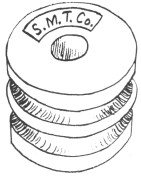
It was found with several other single and double-groove phone knobs, a
number of which were embossed N.E.T. & T. Co. It shows age, and being found
in this area, I strongly suspect it's from the old "So. Mass. Tel.
Co.". It was the only one the dealer had and, for one who lives in the
heart of So. Mass. Tel. country, a steal at $.25.
Jarl Anderson,
E. Freetown, Mass.
- - - - - - - - -
Dear Jarl:
Yep, we all get lucky once in awhile.
Jack
Per my suggestion, Jerry Turner (Goshen, Ohio) was kind enough to make the
following photos for us of some unusual items in his collection.
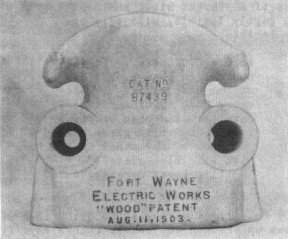
This in Jerry's spectacularly odd Fort Wayne primary fuse cutout (markings
darkened for photo). See the patent for this item in the April 1975 porcelain
column.

Among the numerous very rare porcelains in Jerry's collection (possibly the
best collection existent), these two U-274 with the embossed , "O. P.
CO." marking on top of the brow above the wire groove are really something.
The discovery specimen is owned by Carl Lencse (E. Liverpool, Ohio), and these
two owned by Jerry are the only other specimens I've heard of to date. Having
this rare marking at all is a victory in itself, so locating a brown and a white
pair of them certainly must win the prize!
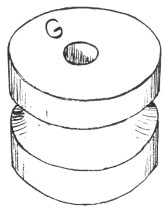
Dear Mr. Tod:
This is a question that I have as the result of cleaning my insulators. I
found that I have a porcelain knob (sketch enclosed) that has a "G"
embossed on the top. It is dark brown with tan splotches where the glaze is
uneven. The "G" is very faint but noticeable because of the unevenness
of the glaze, making the "G" a lighter shade.
My grandmother found it when she lived in Kansas before the family moved to
Indiana in the year 1936. Grandmothers are really nice, aren't they?
Anyway, I remembered the letter from Lew Hohn about the "G" marking
and wondered if this could be the same company. Also are you ready to give out
the name of the company that made these insulators?
Gene Hawkins,
Mooresville, Ind.
- - - - - - - - -
Dear Gene:
You knob is Standard Porcelain-#24 size. Needless to say, these knob sizes
are very, common, but they are quite rare in anything other than the normal
white glaze.
Yes, this "G" is the same company that made the few styles of
"G" dry process pin types, and they made all sorts of dry press items
such as knobs, tubes, cleats, etc. It is our mystery porcelain manufacturer, not
unlike the manufacturer of "Star" glass insulators.
I think the company who used this marking could have been Globe Porcelain
Co., Trenton, N.J., but still have nothing to tie this down. This plant (1913 to
about 1965) was located at 127 Mulberry St. in Trenton. It is now defunct, and
the property was bought by the Renselar Corp. July 19, 1971.(Star Porcelain
owned it for several years.)
I visited this site in April 1973 to look for dump remains that would
indicate anything, but everything has been leveled off and graveled into a large
parking lot. To complicate things, much of the fill used in the grading came
from dumpage of Imperial Porcelain Works, located up Mulberry St. a mile or so.
If a collector in the area could get permission to do some light
"digging" over in the weeded edge of the back lot, maybe something
could be turned up. I did locate a couple of "G" items there, but the
evidence was very inconclusive.
One thing leaves some doubt - and that is that Globe did use the marking
"GLOBE" on some items I found such as nail knobs and #334 cleats. This
would lead one to think they would also use GLOBE on some other knobs such as
yours. Items with "G" marking were also found in the old dumpage of General Porcelain Co. at 'Parkersburg, and we can't rule out Greenwood Pottery
as another possible one.
Really, it would be a shame to reliably attribute this marking. Then we
wouldn't have any mystery left!
Jack
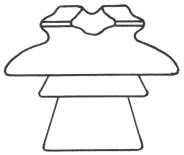
Dear Jack:
... Also I've enclosed a scale sketch of a cemented three-part F. M. Locke I
got at Clifton Park last November. It is very crude, like it was fashioned with
hand tools and carved. The bottom shell in fully 3/4" thick and has a 1-
3/8" pinhole with a zinc thimble which will screw out. Looks like the
thimble was cut from a flat piece, then rolled to fit in. This thimble reduces
the pinhole to standard 1" size. The insulator has an 8-1/2" top skirt
and is 7" tall. Another feature of this goody is that it has the Fred Locke
7-date marking stamp!
Lew Hohn,
Rochester, N.Y.
- - - - - - - - -
Dear Lew:
How come I can't find things like that? Oh well, at least we have nice mild
winters here in Arizona.
Amazing, those old Lockes. Up north of San Francisco there are transmission
lines which still have in use those large, old Fred Locke multis made 75 years
ago. Guess some of Fred's claims in his old catalogs weren't too far off base
after all. Most of these very old insulators were scrapped out because they had
too small wire grooves or because they didn't fit "standards" or have
radio quiet, but I'll bet at today's high factory insulator costs, many
utilities are kicking themselves in the ass for all those serviceable insulators
they hauled to the dump in past years. O-B does sell "radio-treat"
paint.
Jack
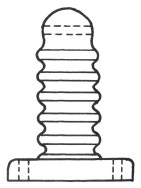
Dear Jack:
... Also enclosed is a drawing of an insulator (radio or neon?) that was
purchased at an antique shop in northern Vermont. It's about 4" tall and
has a very shiny black glaze (but dull black on the bottom firing surface). It
is embossed "FLERON / No. 41" on the side skirts. Any info ... ?
Paul Hirschler,
Cassopolis, Mich.
- - - - - - - - -
Dear Paul:
I have a similar item which was made by Union Porcelain Co. possibly as a
neon tube support insulator, but your item was sold by M. M. Fleron & Sons,
Trenton, N.J., and they were in the radio items business. Just from the fact
that your item is glazed black, I will guess "radio" on it.
Jack
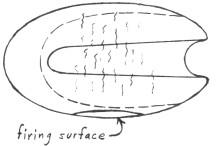
Dear Jack:
We just finished the Third Annual Glass Capitol Insulator Show. I did
some trading, sold a few, and listened to a lot of B.S. I had a swell time
though. Met some new people as well as some old friends.
The reason I am writing is that today, after the show, I found a new
insulator for my collection. It is an egg-shaped strain, quite old by
appearance and in good condition. I found it in an antique shop here in Findlay
and have no idea where it came from.
It has a very poor (uneven) brown glaze, no names or markings, lots of small
cracks around the center and is about 3" by 5-1/4" size (sketch
enclosed). Would appreciate any information you could give me.
Gary Taylor,
Rt 1, Box 151,
Findlay, OH 45840
- - - - - - - - - -
Dear Gary:
These are dry process, open-end guy strain insulators. Some types are more
streamlined (as footballs), and others tend to be more squat (as a chunky hen's
egg). Generally we term all these "egg insulators".
These were made and cataloged by a number of companies making dry press
insulators, most probably starting in the early 1900's, but certainly lasting up
into the 1930's, if not later. In just a few catalogs pulled from my shelf, I
find these cataloged by Federal Porcelain ( FEDCO) 1919, Thomas 1927, and
Illinois 1934.
The sizes (length) in these generally are 2-1/2", 3-1/2", 4-
1/2" and 5-1/2" give or take a bit. The smaller sizes appear to be the
ones most commonly seen (by me).
The only advantage in the design I can see (other than being cheap to make)
is that the enclosing cables make a more naturally rounded bend at the back side
than occurs on the more boxy strain designs.
These are older insulator types not commonly seen, but they do continually
come into utility salvage yards and are thus available to collectors who check
on the stuff being hauled to the dump. Your old 5" model certainly is an
eye catching shelf item for your collection.
Jack
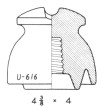
Dear Jack:
Enclosed are drawings of two very old insulators I found on some abandoned
poles, and I had to climb the poles and saw the iron pins off, since the
insulators would not screw off.
The one with the narrower side groove is a yellow-brown color, and the one
with larger side groove is a very black brown.
What is the U- number for this insulator, and can you tell me if they are
rare or not? I will show them to you at the 6th N.I.A. Convention in San Diego,
where I live in Pacific Beach area of San Diego. I am now in school in
Milwaukee.
John E. Contreras
St. John's School for the Deaf
3680 S. Kinnickinnic Ave.
Milwaukee, Wis. 53207
- - - - - - - - -
Dear John:
These insulators are U-616 in our porcelain style chart and were cataloged by
Thomas in 1912 -- your two basically the same insulator but with groove
variations. Until your report, I hadn't heard of anyone else having this style.
Most ordinary cable style porcelains have low collector value in regular
brown glaze and without markings. However, these are very old items and somewhat
unusual in shape. I would class them as a very desirable item for any
collection, and you made a lucky find.
Jack
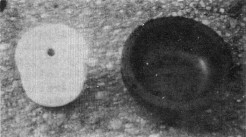
Dear Jack:
The spool on the left in photo has a VIADUCT MFG CO. / BALTO underglaze
marking. Is this a new marking for insulators or is it just another juicer,
toilet part, etc.?
The ashtray is rim embossed AMERICAN INSULATOR CORPORATION, NEW FREEDOM, PA.
and also has their trademark on the bottom side.

Jerry Turner,
Goshen, Ohio
- - - - - - - - - -
Dear Jerry:
Your Baltimore spool looks like another "toilet part" to me,
because I know of no electrical knobs that size with such a small mounting hole,
if that's what the hole in it is for. I'm just guessing that the underglaze
marking you sketched is in green ink, and I'll guess further that it was made by
Specialty Porcelain Works (E. Liverpool, Ohio) for that "toilet
part" company.
Jerry, you're throwing a hooker at me with that Amer. Insulator Corp. ashtray
advertiser, but my files are too much for you now, and you can't trip me up on
this gadget! You didn't say so, but I'll bet you a sausage pizza and beer that
it's made of composition and not porcelain.
This company was listed in old directories as a manufacturer of "molded
insulation, insulators, etc.". The trademark, as you sketched, was
registered #159,796 for "insulating composition materials" on Oct. 10,
1922 (first use claimed Dec. 1916, application filed Sep. 24, 1920). A nice
collection addition, Jerry.
Jack
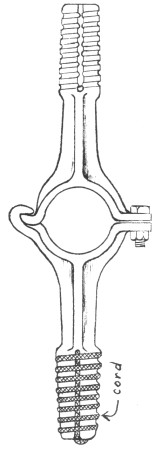
Dear Jack:
... I am also sending this drawing of a cast iron pin with cord threads. I
thought you may know something about it. There's no name or patent number on it.
I would appreciate any info or if you have ever seen or heard of one like this.
Carl Adams,
Findlay, Ohio
- - - - - - - - -
Dear Carl:
Sorry, but I haven't ever seen a pin bracket like this and have no info on
it. (Sketch reduced. Pin is 10" overall.)
It looks like an interesting one, and I'm guessing there is probably a patent
on it. I possibly have the most extensive file on "insulator" patents
of any collector in the country, but I don't keep cards on a number of classes
of related items where there are hundreds of patents each -- such as pins, pin
brackets, wire holders, suspensions, third-rail types, trolley hangers, etc.
There are jillions of different pins and brackets and many patents on them by
Hubbard (Peirce), Joslyn, Fletcher, Line Material and other poleline hardware
companies. I'm sure there are some people who have very good collections of
these. Some I have seen are quite old relics and of unusual design, and yours
with the wound cord for threads looks like a goody for anyone collecting these.
Jack
| 